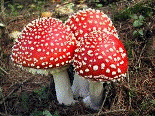Gut Function Initiative
Date of this Version
2009
Document Type
Article
Citation
Fungal Genetics and Biology 46 (2009) 427–435; doi:10.1016/j.fgb.2009.02.001
Abstract
Based on the analysis of its genome sequence, the ectomycorrhizal (ECM) basidiomycetous fungus Laccaria bicolor was shown to be lacking many of the major classes of secreted enzymes that depolymerize plant cell wall polysaccharides. To test whether this is also a feature of other ECM fungi, we searched a survey genome database of Amanita bisporigera with the proteins found in the secretome of Trichoderma reesei (syn. Hypocrea jecorina), a biochemically well-characterized industrial fungus. Additional proteins were also used as queries to compensate for major groups of cell-wall-degrading enzymes lacking in the secretome of T. reesei and to substantiate conclusions drawn from the T. reesei collection. By MS/MS-based ‘‘shotgun” proteomics, 80 proteins were identified in culture filtrates of T. reesei strain RUTC30 grown on corn cell walls and in a commercial ‘‘cellulase” preparation, Spezyme CP. The two T. reesei enzyme preparations were qualitatively and quantitatively similar, the most striking difference being the lack of at least five major peptidases from the commercial enzyme mixture. Based on our analysis of A. bisporigera, this ECM fungus is deficient in many major classes of cell-wall-degrading enzymes, including both glycosyl hydrolases and carbohydrate esterases. By comparison, the genomes of the saprophytic basidiomycetes Coprinopsis cinerea and Galerina marginata (using a genome survey sequence approximately equivalent in depth to that of A. bisporigera) have, like T. reesei, a much more complete complement of cell-wall-degrading enzymes.


Comments
This article is a U.S. government work, and is not subject to copyright in the United States.